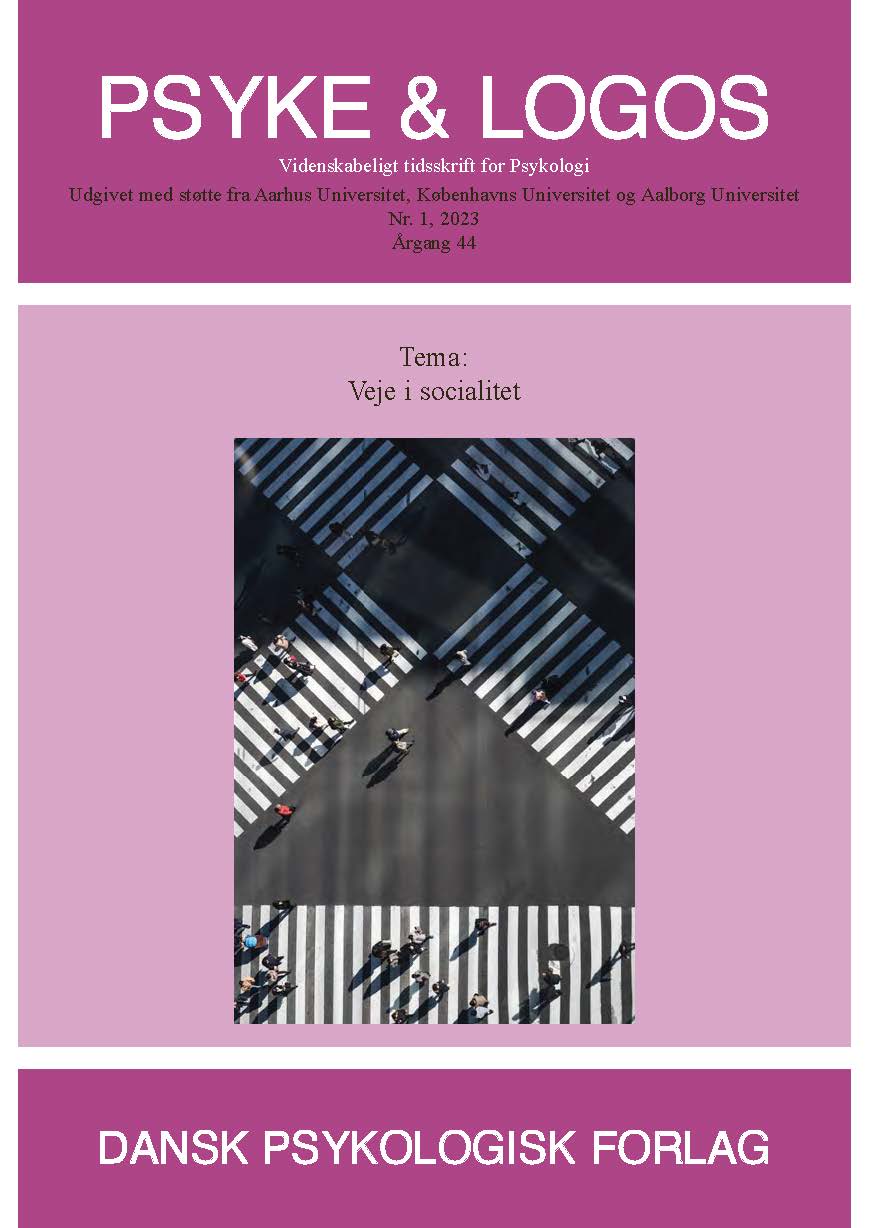UNDERSØGELSE AF SOCIALITET MED SOCIALITET – PRAKSISFORSKNING I SOCIOANALYTISK GRUPPESUPERVISION
DOI:
https://doi.org/10.7146/pl.v44i1.141126Nøgleord:
socioanalytisk supervision, gruppesupervision, social dreaming, kollaborativ praksisforskning, abduktionResumé
Gruppesupervision anvendes på mange arbejdspladser som led i den løbende udvikling af kompetencer og trivsel på individniveau og til udvikling af det faglige og professionelle felt. Vi oplever et problem ved mange af de metoder, der i dag bruges til gruppesupervision, nemlig at de fokuserer for ensidigt på individet som det ene og på bevidste, rationelle overvejelser om konkrete løsninger som det andet. Supervision kan derfor fastholde supervisander i at have et perspektiv centreret om dem selv som individer og føre til instrumentelle forventninger om et udbytte, hvor selve det socialt konstituerede og konstituerende grundlag for arbejdsfeltet udelades. Men når arbejde ikke er et regnestykke, der kan gå op, er der måske mere brug for at finde en anden indgang til at forstå og handle i sit arbejdsfelt, som inddrager ubevidste, tavse og oversete – og dermed mere omfattende – betydninger af socialitet. Vi har derfor undersøgt en såkaldt socioanalytisk tilgang til gruppesupervision for sit potentiale i forhold til at opfylde denne mangel. Både den kollegiale, faglige socialitet, som gør professionelt arbejde muligt i det hele taget, og den samfundsmæssige, organisatoriske og politiske socialitet som kontekst. Artiklen omhandler denne undersøgelse, som er tilgået som kollaborativ praksisforskning og har fundet sted på arbejdspladser, der arbejder med menneskelig udvikling og velfærd.
Referencer
Agnati, L.F., Guidolin, D., Battistin, L., Pagnoni, G. & Fuxe, K. (2013). The neurobiology of imagination: Possible role of interaction-dominant dynamics and default mode network. Frontiers in Psychology, 4. https://doi.org/10.3389/fpsyg.2013.00296.
Andersen, T. (1987). The reflecting team: Dialogue and meta-dialogue in clinical work. Family Process, 26(4), 415-428. https://doi.org/10.1111/j.1545-5300.1987.00415.x.
Andersen, T. (2007). Reflekterende processer samtaler og samtaler om samtalerne (3. udg.). Dansk Psykologisk Forlag.
Bain, A. (1999). On socio-analysis. Socioanalysis, 1999(1), 1-17. https://doi.org/10.1023/A:1021328511886.
Bentzen, M. & Hart, S. (2005). Psykoterapi og neuroaffektiv udvikling. Psykolog Nyt, 2.
Bion, W.R. (1961). Experiences in groups and other papers. Tavistock/Routledge. https://doi.org/10.4324/9780203359075.
Deleuze, G. & Guattari, F. (1987). A Thousand Plateaus: Capitalism and Schizophrenia. Bloomsbury Academic.
Foulkes, S.H. (1975). A short outline of the therapeutic processes in group-analytic psychotherapy. Group Analysis. https://doi.org/10.1177/053331647500800111.
Foulkes, S.H. (2018). Therapeutic Group Analysis (1. udg.). Routledge. https://doi.org/10.4324/9780429483899.
Hassing Pedersen, J. (2016). Supervision i et organisatorisk perspektiv. Dansk Psykologisk Forlag.
Hassing Pedersen, J. (2018). Supervision – mellem fagprofessionel læring og organisatorisk udvikling. I: L.T. Kongsgaard & M.H. Rod (red.), Bedre begrundet praksis. Samfundslitteratur.
Hawkins, P. & Shohet, R. (2012). Supervision in the Helping Professions (4. udg.). Open University Press.
Holmgren, A. & Holmgren, A. (red.). (2015). Narrativ supervision og vejledning. DiSPUK.
Jung, C.G. (1985). The Practice of Psychotherapy: Essays on the Psychology of the Transference and Other Subjects (2. ed.) Princeton University Press.
Jung, C.G. (1969). The Structure and Dynamics of the Psyche (2. udg.). Princeton University Press.
Lawrence, W.G. (ed.) (1998). Social Dreaming @ Work. Karnac Books.
Lawrence, W.G. (2005). Introduction to Social Dreaming: Transforming Thinking. Karnac Books.
Long, S. (red.) (2013). Socioanalytic Methods: Discovering the Hidden in Organisations and Social Systems. Karnac Books. https://doi.org/10.4324/9780429480355.
Long, S. & Manley, J. (2019). Social Dreaming: Philosophy, Research, Theory and Practice. Routledge. https://doi.org/10.4324/9780429449277.
Odde, D. & Vestergaard, A. (2021). A preliminary sketch of a Jungian socioanalysis – an emerging theory combining analytical psychology, complexity theories, sociological theories, socio- and psycho-analysis, group analysis and affect theories. Journal of Analytical Psychology, 66(2), 301-322. https://doi.org/10.1111/1468-5922.12667.
Olsen, O. Ankjær. (2019). Psykodynamisk leksikon: Den psykodynamiske psykologi fremstillet i 548 encyklopædiske artikler og 313 kortere biografier (2. udg.). Hans Reitzel Forlag.
Peirce, C.S. (1994). Semiotik og pragmatisme. Gyldendal.
Reason, P. & Bradbury, H. (red.) (2001). Handbook of Action Research: Participative Inquiry and Practice. SAGE.
Rønnestad, M.H. & Reichelt, S. (1999). Psykoterapiveiledning. Tano-Aschehoug.
Schilling, B. (2007). Systemisk supervisionsmetodik: Et sprogspil for professionelle der anvender supervision (2. udg., 2. opl.). Dansk Psykologisk Forlag.
Schilling, B. (1997). Systemisk supervision: En historie om den systemiske supervision gennem 45 år. Dansk Psykologisk Forlag.
Stacey, R.D. (2007). Strategic Management and Organisational Dynamics: The Challenge of Complexity to Ways of Thinking about Organisations (5. udg.). Financial Times Prentice Hall.
Taylor, C. (2004). Modern Social Imaginaries. Duke University Press. https://doi.org/10.1215/9780822385806.
Thorup et al. (2015). Samskabelse – En værdiskabende strategi i en kompleks kommunal hverdag. COK – Center for offentlig kompetenceudvikling.
Vestergaard, A. & Odde, D. (2021). Jungian socioanalysis, social dreaming and the emerging complexity of Europe. Journal of Analytical Psychology, 66(2), 323-344. https://doi.org/10.1111/1468-5922.12668.
White, M. (2007). Maps of Narrative Practice. W.W. Norton & Co.
Downloads
Publiceret
Citation/Eksport
Nummer
Sektion
Licens
Ophavsret er tidsskriftets og forfatternes. Det er gældende praksis, at artikler publiceret i Psyke & Logos, som efterfølgende oversættes til andet sprog, af forfatteren frit kan publiceres i internationale tidsskrifter, dog således at det ved reference fremgår, at den oversatte artikel har et forlæg i en dansksproget version i Psyke & Logos. Artikler kan frit deles og linkes til på forsknings- og undervisningsnetværk (så som Blackboard). Link foretrækkes, fordi det giver oplysning om brug af tidsskriftets artikler.




